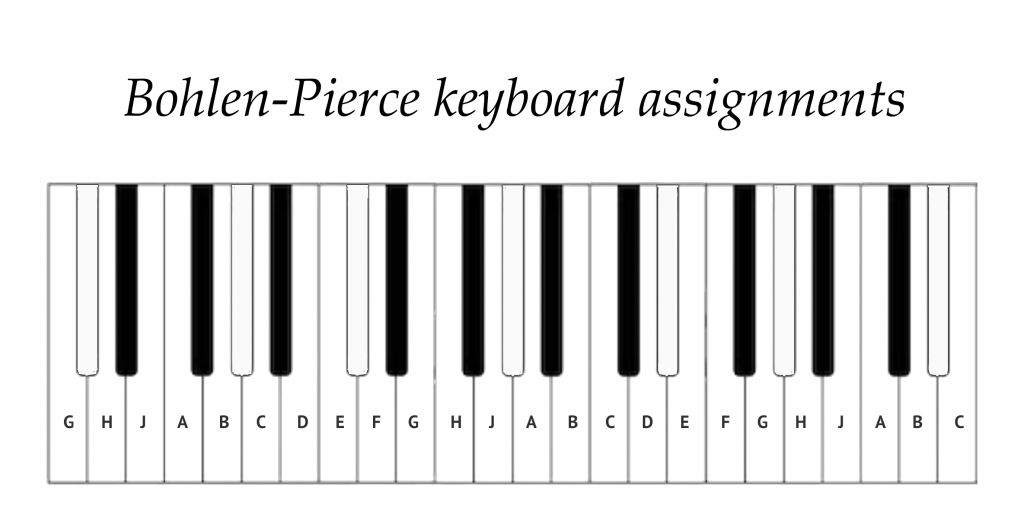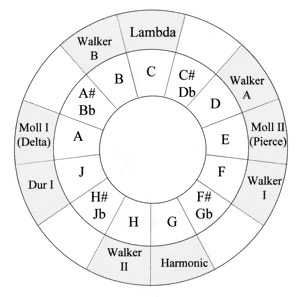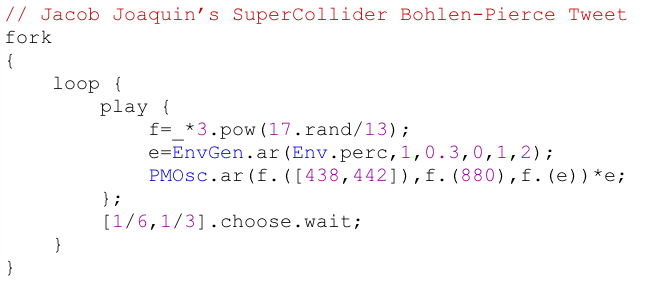Here’s one way to adapt a standard 12-tone keyboard to play Bohlen-Pierce music. Some of the black keys are not used because the BP scale has fewer accidentals. The actual pitch reassignments must be done in software somehow.

Here’s one way to adapt a standard 12-tone keyboard to play Bohlen-Pierce music. Some of the black keys are not used because the BP scale has fewer accidentals. The actual pitch reassignments must be done in software somehow.

I usually tune my steel guitars to D6 with G bass (G B D F# A B D F#). The Bohlen-Pierce tuning below uses the same string gauges with a BP fretboard designed by Andy DePaule. I simply place the fretboard over the standard one and retune to play in BP.
If you use a Peterson Strobe HD tuner, you can install the BP tuning table from the “Uncategorized” list at petersontuners.com/sweeteners/shared. That’s a lot easier than eyeballing the cents numbers on a traditional electronic tuner.
| BP note | 12 EDO Tuning |
| H | F -39 |
| G | Eb +14 |
| F | C +22 |
| Db | Ab -17 |
| C | Gb +37 |
| A | D -2 |
| H | Bb -41 |
| F | F +20 |
Here’s some ambient music played on it:
This Bohlen-Pierce arrangement of Terry Riley’s “In C” was realized on the musical hardware described in Rehearsal Room. It was performed by 13 identical algorithmic musicians known collectively as The Technical Academy. A characteristic feature of the ensemble is an indiscriminate fader controlled by a Markov chain on each voice. This is the third recording of the completed algorithm.
The notes of Terry Riley’s original score were remapped to Bohlen-Pierce notes in a slightly modified A Moll I mode; the B note would have mapped to BP’s J, but it was changed to Jb simply because Jb sounded better. Riley’s C D E F F# G A Bb B becomes A B C D E F G H Jb. The work is titled “Not In C” because it’s based on this different scale.
Source code written in Ruby can be viewed at github.com/b0blee/TechAcademy.
This table demonstrates some of the logic behind the Lambda scale. It shows the 17-limit just intonation (JI) intervals that are closest to the equally tempered Bohlen Pierce scale. Notice that there are no close JI intervals for the F#, H#, and A# notes. Also, melody fragments in the D E F G range are virtually equal tempered with respect to one another.
The original JI scale has accidentals that are beyond the 17 limit: C# is 25/21, F# is 75/49, H# is 49/25, and A# is 63/25. Using those ratios would bring the accidentals within 10 cents of the ET notes, but the ear gravitates towards ratios with lower denominators. In any case, it’s good to avoid H# because of its proximity to the octave. 49/25 can’t compete with 2/1. Same with A# against a strong C – most listeners will hear it as a too-sharp 10th.
| Bohlen Pierce ET to JI intervals best match, 17 limit |
|||||
| ET cents | JI | JI cents | diff | ||
| 0 | 0.0 | 1/1 | 0.0 | +0.0 | C |
| 1 | 146.3 | 12/11 | 150.6 | +4.3 | |
| 2 | 292.6 | 13/11 | 289.2 | -3.4 | D |
| 3 | 438.9 | 9/7 | 435.1 | -3.8 | E |
| 4 | 585.2 | 7/5 | 582.5 | -2.7 | F |
| 5 | 731.5 | 17/11 | 753.6 | +22.1 | |
| 6 | 887.8 | 5/3 | 884.4 | -3.4 | G |
| 7 | 1024.1 | 9/5 | 1017.6 | -6.5 | H |
| 8 | 1170.4 | 2/1 | 1200.0 | +29.6 | |
| 9 | 1316.7 | 15/7 | 1319.4 | +2.7 | J |
| 10 | 1463.0 | 7/3 | 1466.9 | +3.9 | A |
| 11 | 1609.3 | 5/2 | 1586.3 | -23.0 | |
| 12 | 1755.7 | 11/4 | 1751.3 | -4.4 | B |
| 13 | 1902.0 | 3/1 | 1902.0 | +0.0 | C |

I acquired a nice little 17-key kalimba (thumb piano), and tuned it to BP with a Korg AT-1 chromatic tuner. It sounds real nice. Here’s a demo just fooling around with it:
17-key Kalimba BP Notes
(highest to lowest)
| BP note | 12 EDO Tuning |
| H | C -37 |
| G | Bb +17 |
| Gb | A -30 |
| F | G +24 |
| E | F# -22 |
| D | E -32 |
| Db | Eb -15 |
| C | Db +39 |
| B | C -7 |
| Bb | Bb +46 |
| A | A (440 Hz) |
| J | Ab -47 |
| Jb | F# +7 |
| H | F -39 |
| G | Eb +14 |
| Gb | D -32 |
| F | C +22 |
SuperCollider is an algorithmic music language that can be used to generate microtonal music. Here’s a quick example of random Bohlen-Pierce notes.

This is a tribute to the early music of Steve Reich. It was realized on the Sonic Pi, using the Bohlen-Pierce scale, equal tempered as MIDI notes.
Source code:
# Reichish Phase
tritave = 19.02 # a 3/2 tritave is 1902 cents, or 19.02 in MIDI
half = tritave / 13 # size of the BP half step in MIDI
whole = half * 2
a3 = 69 # MIDI 69 is A440
b3 = a3 + whole
c3 = b3 + half
d3 = c3 + whole
e3 = d3 + half
f3 = e3 + half
g3 = f3 + whole
h3 = g3 + half
j3 = h3 + whole
a4 = a3 + tritave
a2 = a3 - tritave
b2 = b3 - tritave
c2 = c3 - tritave
d2 = d3 - tritave
e2 = e3 - tritave
f2 = f3 - tritave
g2 = g3 - tritave
h2 = h3 - tritave
j2 = j3 - tritave
notes = (ring a2, a3, f2, c2, c3, h2, e2, e3, b2, g2, g3, d2, j2)
in_thread(name: :slower) do
use_synth :pretty_bell
for i in 0..326
print i
n = notes.tick
np = n / a4
play n, amp: 1.0 - np, pan: -np / 2
sleep rrand(0.298,0.302)
i +=1
end
end
in_thread(name: :faster) do
use_synth :pretty_bell
for i in 0..329
print i
n = notes.tick
np = n / a4
play n, amp: 1.0 - np, pan: np / 2
sleep rrand(0.294,0.3)
i +=1
end
end
Using a sampled A=440Hz piano note, I squished and stretched it to play a BP chromatic scale. Here it is juxtaposed against random MIDI BP notes using the Sonic Pi’s FM synth.
Code:
# Bohlen-Pierce notes
tritave = 19.02 # a 3/2 tritave is 1902 cents, or 19.02 in MIDI
half = tritave / 13 # size of the BP half step in MIDI
whole = half * 2
a = 69 # MIDI 69 is A440
b = a + whole
c = b + half
d = c + whole
e = d + half
f = e + half
g = f + whole
h = g + half
j = h + whole
a_ = a + tritave
bpScale = [a,b,c,d,e,f,g,h,j,a_]
exp = 3 ** (1.0/13)
# play random notes with FM synth
divs = [1.0/exp,exp,1] # divisors add random BP flavor for FM synth
in_thread do
use_synth :fm
for i in 0..48
highN = bpScale.choose
lowN = highN - tritave
play highN, divisor: divs.choose, depth: 0.5, pan: 49/highN, amp: rrand(0.1,0.2), attack: rrand(0,0.01), sustain: 0.2, release: rrand(0.1,0.5)
sleep 0.15
play lowN, divisor: divs.choose, depth: 0.7, pan: -34/lowN, amp: rrand(0.1,0.2), attack: rrand(0,0.01), sustain: 0.2, release: rrand(0.1,0.5)
sleep 0.15
end
end
# play chromatic BP scale with sampled piano
speed = 5.0/9 # initial sample speed yields BP E note (JI) calculated from A=440Hz
for i in 1..36
sample "~/Sonic Pi/piano-a440.wav", rate: speed, pan: speed - 1.5, amp: rrand(1.0/3,2.0/3)
speed = i < 18 ? speed * exp : speed / exp
sleep 0.4
end
Way back in 1991, I produced an album of algorithmic music. It has recently been re-released by Fixture Records. Renewed interest in the project sent me on a quest for a comparable modern programming environment, one that would also support BP compositions.
I’m pleased to report that I’ve found such a platform in a program called Sonic Pi. Originally written for the Raspberry Pi miniature computer, the program is now also available for Mac OS X and Windows. My first quick attempt at producing BP tones was incredibly easy. I’m very excited at the possibilities here.
Here is a screen shot of the program, followed by an MP3 of the sounds it produced.